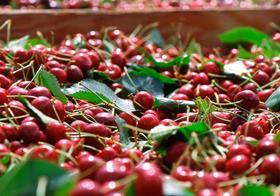
Not only the earliest crop in 20 years, the 2015 Northwest cherry season has come it at the third largest in history with an estimated 20.52m boxes shipped, according to the Northwest Cherry Growers (NWCG) preliminary 2015 season recap.
Exports sat at just over 30 per cent of the shipped crop, with the last fruit of the 2015 Northwest cherry season probably shipped from Washington state cold storage about mid-August.
While the season was by no means a disaster, it was hardly a shining success. Actually, it was a challenge from start to finish.
At the root of the problems was weather; the primary growing areas of the five-state region represented by NWCG, Washington and Oregon, have been coping with drought conditions for the last couple of years.
Extreme temperatures often accompany drought, impacting on cherry quality as well as yields, and that was the case leading up to the recent season. The first of the weather events to influence the 2015 crop occurred in November of last year, when an arctic air mass descended Oregon’s Hood River growing region doing significant damage to cherry trees and limiting production for the coming season.
Thereafter, the weather did an about-face and turned very mild, even ‘warm’ by normal standards, producing only minimal snowfall in the adjacent Cascade Mountains, with spring-like conditions prevailing in the valleys below.
Many cherry orchards were in full bloom by the last week of March, leading the harvest to kick-off on 23 May, which was the earliest start to a season in recent memory.
From that point until the final shipments left cold storage in mid-August, the 2015 Northwest cherry deal ran at a frantic pace. The industry shipped 500,000 cartons (9.1kg) by the end of May and a record 12.5m in June. Shipments peaked at 595,000 cartons on 25 June, 16 days earlier than in 2014, averaging a half million boxes per day from 15 June through to 26 June.
From the start, growers continued to be plagued by extreme weather. After months of little or no rain, the first week of harvesting in late May was greeted with untimely precipitation that caused widespread splitting of fruit in the Tri-Cities region. June turned out to be the warmest on record by nearly 3F (1.65C) and, statistically, shouldn’t occur again for another 400 years.
Industry observers still expect to see the Northwest cherry volume top 25m shipped cartons in the near future as new, higher yielding acreage comes into bearing.



